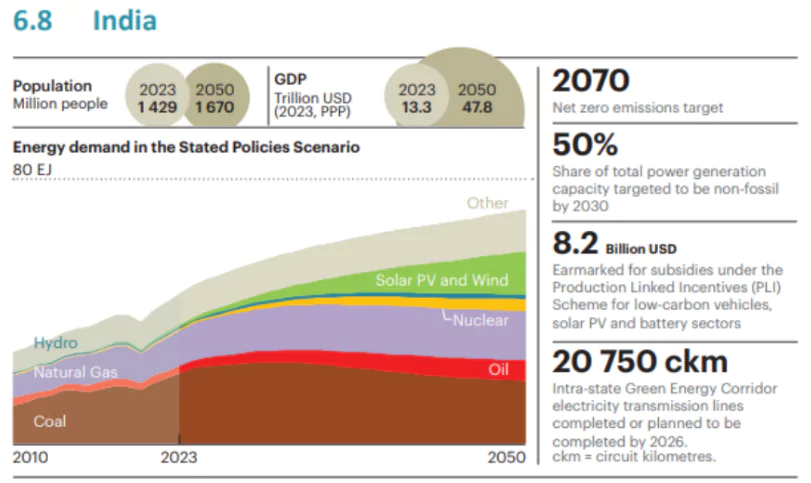Recently, The International Energy Agency(IEA) has released the World Energy Outlook 2024.
What is the World Energy Outlook 2024?
- Released by: International Energy Agency(IEA)
- Objective: To offer detailed analysis and strategic insights into all parts of the global energy system.
Key findings of the World Energy outlook 2024
India Specific Findings
India’s energy and transportation sectors are undergoing significant changes as the country emerges as a major player in the global economy.
-
Economic Growth and Population Trends
- Rapid Growth: India was the fastest-growing major economy in 2023, with a growth rate of 7.8%.
- Population Milestone: In 2023, India became the most populous country in the world, surpassing China, even as its birth rate declined.
Enroll now for UPSC Online Course
-
Energy Challenges
- Universal Clean Cooking Access: Ensuring everyone has access to clean cooking facilities is a priority.
- Fossil Fuel Dependence: India aims to reduce its reliance on fossil fuel imports.
 Power Sector Reliability: There is a need to improve the reliability of electricity supply and the financial health of distribution companies.
Power Sector Reliability: There is a need to improve the reliability of electricity supply and the financial health of distribution companies.- Air Pollution: Addressing high levels of air pollution is crucial.
- Climate Extremes: The country must manage the impacts of extreme weather, such as heat waves and floods.
-
Rising Energy Demand
- Increased Demand: India’s energy demand is expected to grow more than any other country in the next decade.
- Industrial Growth: By 2035, production of iron and steel is expected to rise by 70%, cement by nearly 55%, and the number of air conditioners is projected to increase more than fourfold.
-
Coal’s Role in Energy Mix
- Continued Use: Coal will remain a significant part of India’s energy mix, with an increase in coal-fired capacity and generation by 2030.
- Industry Reliance: In 2023, coal provided 40% of the energy needed by industries. By 2035, coal use in industries is expected to grow by 50%.
-
Net Zero Emissions Commitment
- Long-Term Goals: India aims for net zero emissions by 2070.
- Increased Clean Energy: In this scenario, clean power generation will be nearly 20% higher than in other projections by 2035.
- Electric Mobility Rise: The growth of electric vehicles (EVs) will help peak oil consumption in the 2030s.
Check Out UPSC CSE Books From PW Store
-
Electric Vehicle (EV) Growth
- Major Market: India is a leading market for two/three-wheel vehicles and the fourth-largest passenger car market globally.
- Future Projections: Over the next decade, India will add over 37 million cars and 75 million two/three-wheelers.
- Oil Demand Increase: Oil demand from road transport is projected to rise by 40% by 2035, leading to increased dependence on oil imports.
- Market Trends in EV Sales
- Current EV Market: Today, 5% of two-wheelers, 50% of three-wheelers, and 7% of buses sold in India are electric.
- Future Projections: Two/three-wheelers and buses will see faster rates of electrification than passenger cars due to government support and market conditions.
- Lower Emissions Goal: With increased electrification, oil demand and CO2 emissions from road transport could be around 17% lower by 2035 than in other scenarios.
Global Market findings
-
Energy Security
- Rising Risks: Energy security is a big concern, especially with increasing tensions in the Middle East.
- Strait of Hormuz: About 20% of the world’s oil and liquefied natural gas (LNG) passes through this region, making it an area of concern.
- Supply Disruptions: Conflicts in the Middle East could disrupt oil and gas supplies in the near future.
- Energy Access Improvements: By 2030, an extra 550 million people will have access to clean cooking, and 200 million more will have electricity.
-
Energy Transition
- Slower Energy Demand Growth: Global energy demand will grow more slowly because of better efficiency, more use of electricity, and the rise of renewable energy.
- Electric Cars: By 2030, nearly half of all cars sold will be electric, but delays in building charging stations or policies could slow this progress.
- More Renewable Energy: Clean energy will meet nearly all new demand for energy from 2023 to 2035. Solar energy could be produced at three times the rate compared to 2023.
Enroll now for UPSC Online Classes
-
Uncertainty in Energy Demand
-
- Peak Fossil Fuel Demand: Global demand for fossil fuels is expected to reach its peak before 2030, though this will differ between countries based on their development stage.
- Clean Energy Investment Gaps: Many emerging economies outside China have limited clean energy investment, even though they make up two-thirds of the world’s population.
- More investment is needed to support clean energy in these regions.
![]() 19 Oct 2024
19 Oct 2024
 Power Sector Reliability: There is a need to improve the reliability of electricity supply and the financial health of distribution companies.
Power Sector Reliability: There is a need to improve the reliability of electricity supply and the financial health of distribution companies.